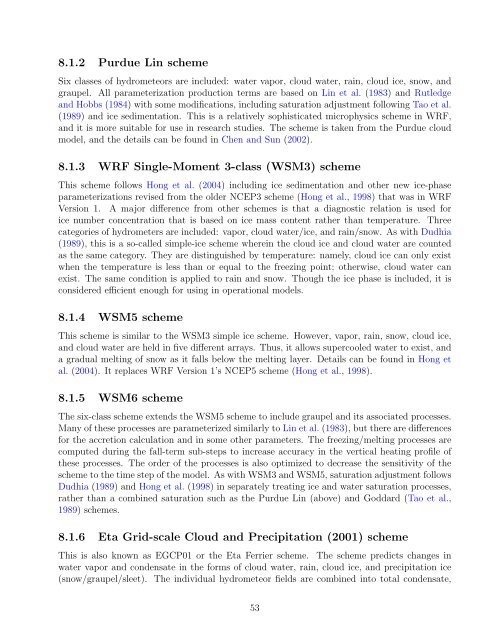Advanced Research WRF (ARW) Technical Note - MMM - University ...
Advanced Research WRF (ARW) Technical Note - MMM - University ...
Advanced Research WRF (ARW) Technical Note - MMM - University ...
Create successful ePaper yourself
Turn your PDF publications into a flip-book with our unique Google optimized e-Paper software.
8.1.2 Purdue Lin scheme<br />
Six classes of hydrometeors are included: water vapor, cloud water, rain, cloud ice, snow, and<br />
graupel. All parameterization production terms are based on Lin et al. (1983) and Rutledge<br />
and Hobbs (1984) with some modifications, including saturation adjustment following Tao et al.<br />
(1989) and ice sedimentation. This is a relatively sophisticated microphysics scheme in <strong>WRF</strong>,<br />
and it is more suitable for use in research studies. The scheme is taken from the Purdue cloud<br />
model, and the details can be found in Chen and Sun (2002).<br />
8.1.3 <strong>WRF</strong> Single-Moment 3-class (WSM3) scheme<br />
This scheme follows Hong et al. (2004) including ice sedimentation and other new ice-phase<br />
parameterizations revised from the older NCEP3 scheme (Hong et al., 1998) that was in <strong>WRF</strong><br />
Version 1. A major difference from other schemes is that a diagnostic relation is used for<br />
ice number concentration that is based on ice mass content rather than temperature. Three<br />
categories of hydrometers are included: vapor, cloud water/ice, and rain/snow. As with Dudhia<br />
(1989), this is a so-called simple-ice scheme wherein the cloud ice and cloud water are counted<br />
as the same category. They are distinguished by temperature: namely, cloud ice can only exist<br />
when the temperature is less than or equal to the freezing point; otherwise, cloud water can<br />
exist. The same condition is applied to rain and snow. Though the ice phase is included, it is<br />
considered efficient enough for using in operational models.<br />
8.1.4 WSM5 scheme<br />
This scheme is similar to the WSM3 simple ice scheme. However, vapor, rain, snow, cloud ice,<br />
and cloud water are held in five different arrays. Thus, it allows supercooled water to exist, and<br />
a gradual melting of snow as it falls below the melting layer. Details can be found in Hong et<br />
al. (2004). It replaces <strong>WRF</strong> Version 1’s NCEP5 scheme (Hong et al., 1998).<br />
8.1.5 WSM6 scheme<br />
The six-class scheme extends the WSM5 scheme to include graupel and its associated processes.<br />
Many of these processes are parameterized similarly to Lin et al. (1983), but there are differences<br />
for the accretion calculation and in some other parameters. The freezing/melting processes are<br />
computed during the fall-term sub-steps to increase accuracy in the vertical heating profile of<br />
these processes. The order of the processes is also optimized to decrease the sensitivity of the<br />
scheme to the time step of the model. As with WSM3 and WSM5, saturation adjustment follows<br />
Dudhia (1989) and Hong et al. (1998) in separately treating ice and water saturation processes,<br />
rather than a combined saturation such as the Purdue Lin (above) and Goddard (Tao et al.,<br />
1989) schemes.<br />
8.1.6 Eta Grid-scale Cloud and Precipitation (2001) scheme<br />
This is also known as EGCP01 or the Eta Ferrier scheme. The scheme predicts changes in<br />
water vapor and condensate in the forms of cloud water, rain, cloud ice, and precipitation ice<br />
(snow/graupel/sleet). The individual hydrometeor fields are combined into total condensate,<br />
53
















